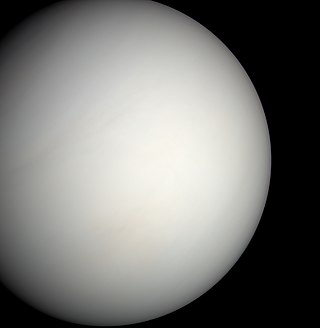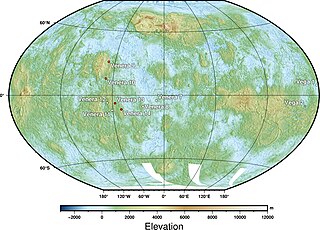
Interplanetary spaceflight or interplanetary travel is the crewed or uncrewed travel between stars and planets, usually within a single planetary system. In practice, spaceflights of this type are confined to travel between the planets of the Solar System. Uncrewed space probes have flown to all the observed planets in the Solar System as well as to dwarf planets Pluto and Ceres, and several asteroids. Orbiters and landers return more information than fly-by missions. Crewed flights have landed on the Moon and have been planned, from time to time, for Mars, Venus and Mercury. While many scientists appreciate the knowledge value that uncrewed flights provide, the value of crewed missions is more controversial. Science fiction writers propose a number of benefits, including the mining of asteroids, access to solar power, and room for colonization in the event of an Earth catastrophe.

Venus is the second planet from the Sun. It has the densest atmosphere of all rocky bodies in the Solar System, so dense that at surface level and 92 atmospheres, it is a supercritical fluid. The planet's surface is dominated by volcanoes – there are 167 Venusian volcanoes that are over 100 km (60 mi) across. Venus has a diameter roughly equal to Earth's at 12,104 km (7,521 mi) and is classified as a terrestrial planet.
A synchronous orbit is an orbit in which an orbiting body has a period equal to the average rotational period of the body being orbited, and in the same direction of rotation as that body.

The Venera program was the name given to a series of space probes developed by the Soviet Union between 1961 and 1984 to gather information about the planet Venus.

Aerobraking is a spaceflight maneuver that reduces the high point of an elliptical orbit (apoapsis) by flying the vehicle through the atmosphere at the low point of the orbit (periapsis). The resulting drag slows the spacecraft. Aerobraking is used when a spacecraft requires a low orbit after arriving at a body with an atmosphere, as it requires less fuel than using propulsion to slow down.

The Magellan spacecraft was a 1,035-kilogram (2,282 lb) robotic space probe launched by NASA of the United States, on May 4, 1989, to map the surface of Venus by using synthetic-aperture radar and to measure the planetary gravitational field.

The Japan Aerospace Exploration Agency (JAXA) is the Japanese national air and space agency. Through the merger of three previously independent organizations, JAXA was formed on 1 October 2003. JAXA is responsible for research, technology development and launch of satellites into orbit, and is involved in many more advanced missions such as asteroid exploration and possible human exploration of the Moon. Its motto is One JAXA and its corporate slogan is Explore to Realize.

H-IIA (H-2A) is an active expendable launch system operated by Mitsubishi Heavy Industries (MHI) for the Japan Aerospace Exploration Agency. These liquid fuel rockets have been used to launch satellites into geostationary orbit; lunar orbiting spacecraft; Akatsuki, which studied the planet Venus; and the Emirates Mars Mission, which was launched to Mars in July 2020. Launches occur at the Tanegashima Space Center. The H-IIA first flew in 2001. As of December 2021, H-IIA rockets were launched 45 times, including 39 consecutive missions without a failure, dating back to 29 November 2003.

In astrodynamics and aerospace, a delta-v budget is an estimate of the total change in velocity (delta-v) required for a space mission. It is calculated as the sum of the delta-v required to perform each propulsive maneuver needed during the mission. As input to the Tsiolkovsky rocket equation, it determines how much propellant is required for a vehicle of given empty mass and propulsion system.
An areostationary orbit or areosynchronous equatorial orbit (AEO) is a circular areosynchronous orbit (ASO) in the Martian equatorial plane about 17,032 km (10,583 mi) above the surface, any point on which revolves about Mars in the same direction and with the same period as the Martian surface. Areostationary orbit is a concept similar to Earth's geostationary orbit (GEO). The prefix areo- derives from Ares, the ancient Greek god of war and counterpart to the Roman god Mars, with whom the planet was identified. The modern Greek word for Mars is Άρης (Áris).

Akatsuki, also known as the Venus Climate Orbiter (VCO) and Planet-C, is a Japan Aerospace Exploration Agency (JAXA) space probe tasked with studying the atmosphere of Venus. It was launched aboard an H-IIA 202 rocket on 20 May 2010, but failed to enter orbit around Venus on 6 December 2010. After the craft orbited the Sun for five years, engineers successfully placed it into an alternative Venusian elliptic orbit on 7 December 2015 by firing its attitude control thrusters for 20 minutes and made it the first Japanese satellite orbiting Venus.
Orbit insertion is the spaceflight operation of adjusting a spacecraft’s momentum, in particular to allow for entry into a stable orbit around a planet, moon, or other celestial body. This maneuver involves either deceleration from a speed in excess of the respective body’s escape velocity, or acceleration to it from a lower speed.

Aphrodite Terra is one of the three continental regions on the planet Venus, the others being Ishtar Terra and Lada Terra. It is named for Aphrodite, the Greek equivalent of the goddess Venus, and is found near the equator of the planet. Aphrodite Terra is about half the size of Africa, making it the largest of the terrae.

Observations of the planet Venus include those in antiquity, telescopic observations, and from visiting spacecraft. Spacecraft have performed various flybys, orbits, and landings on Venus, including balloon probes that floated in the atmosphere of Venus. Study of the planet is aided by its relatively close proximity to the Earth, compared to other planets, but the surface of Venus is obscured by an atmosphere opaque to visible light.

The atmosphere of Venus is primarily of supercritical carbon dioxide and is much denser and hotter than that of Earth. The temperature at the surface is 740 K, and the pressure is 93 bar (1,350 psi), roughly the pressure found 900 m (3,000 ft) underwater on Earth. The Venusian atmosphere supports opaque clouds of sulfuric acid, making optical Earth-based and orbital observation of the surface impossible. Information about the topography has been obtained exclusively by radar imaging. Aside from carbon dioxide, the other main component is nitrogen. Other chemical compounds are present only in trace amounts.

The exploration of Mercury has a minor role in the space interests of the world. It is the least explored inner planet. As of 2015, the Mariner 10 and MESSENGER missions have been the only missions that have made close observations of Mercury. MESSENGER made three flybys before entering orbit around Mercury. A third mission to Mercury, BepiColombo, a joint mission between the Japan Aerospace Exploration Agency (JAXA) and the European Space Agency, is to include two probes. MESSENGER and BepiColombo are intended to gather complementary data to help scientists understand many of the mysteries discovered by Mariner 10's flybys.

Venus Orbiting Imaging Radar was a planned 1983 U.S. spacecraft mission to Venus that was primarily intended to use a microwave imaging radar to perform mapping of the Venusian surface. The goal was to map up to 50% of the planet's surface down to a resolution of 2 km with the eventual goal of targeting landers and atmospheric probes. A 1978 study evaluated the potential use of synthetic aperture radar to achieve 200 meter resolution. The spacecraft was to be launched from the Space Shuttle using a twin stage IUS in December 1984, and arrive in orbit May 1985. The mission was expected to last until November 1985.
The following outline is provided as an overview of and topical guide to Venus:















